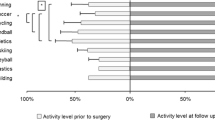Abstract
Resection of the lower patellar pole provides good results in the treatment of jumper’s knee. Therefore we hypothesized that the length of the lower patellar pole is increased in patients with chronic patellar tendinopathy. Cohort study, level of evidence 2. Between 2000 and 2005, 25 patients with chronic patellar tendinopathy underwent conservative and surgical treatment in our clinic. All of them had preoperative MRI were three independent examiners measured the Caton Index, the length and the ratio of the articular and non-articular patellar surface, tendon length and thickness and the thickness and length of the hypodens lesions in the patellar tendon. The measurements were compared with 50 MRI of a control group with no clinical patellofemoral disorders or patellar tendinopathy. Significant changes in tendon thickness (9.42 ± 2.87 vs. 4.88 ± 1.13; P < 0.0001), a longer non-articular surface of the patella (10.62 ± 2.86 vs. 7.098 ± 2.53; P < 0.0001) and significant higher ratio between the articular and the non-articular patellar surface (0.32 vs. 0.24; P < 0.0001) were found in the jumper’s knee group. No significant changes were seen in the length of the articular surface or the Caton Index. The development of chronic patellar tendinopathy in athletes might be associated with a longer lower patellar pole as patients with jumper’s knee showed a longer non-articular patellar surface compared with the control group.




Similar content being viewed by others
References
Blazina ME, Kerlan RK, Jobe FW et al (1973) Jumper’s knee. Orthop Clin North Am 4:665–678
Caton J, Deschamps G, Chambat P et al (1982) Patella infera. Apropos of 128 cases. Rev Chir Orthop Reparatrice Appar Mot 68:317–325
Cook JL, Khan KM (2001) What is the most appropriate treatment for patellar tendinopathy? Br J Sports Med 35:291–294
Cook JL, Khan KM, Harcourt PR et al (1997) A cross sectional study of 100 athletes with jumper’s knee managed conservatively and surgically. The Victorian Institute of Sport Tendon Study Group. Br J Sports Med 31:332–336
Cook JL, Khan KM, Harcourt PR et al (1998) Patellar tendon ultrasonography in asymptomatic active athletes reveals hypoechoic regions: a study of 320 tendons. Victorian Institute of Sport Tendon Study Group. Clin J Sport Med 8:73–77
Cook JL, Khan KM, Kiss ZS et al (2001) Asymptomatic hypoechoic regions on patellar tendon ultrasound: A 4-year clinical and ultrasound followup of 46 tendons. Scand J Med Sci Sports 11:321–327
Cook JL, Malliaras P, De Luca J et al (2005) Vascularity and pain in the patellar tendon of adult jumping athletes: a 5 month longitudinal study. Br J Sports Med 39:458–461
Johnson DP (1998) Arthroscopic surgery for patellar tendonitis: A new technique. Arthroscopy 14(1):44
Johnson DP, Wakeley CJ, Watt I (1996) Magnetic resonance imaging of patellar tendonitis. J Bone Joint Surg Br 78:452–457
Kettunen JA, Kvist M, Alanen E, Kujala UM (2002) Long-term prognosis for jumper’s knee in male athletes. A prospective follow-up study. Am J Sports Med 30:689–692
Khan KM, Bonar F, Desmond PM et al (1996) Patellar tendinosis (jumper’s knee): findings at histopathologic examination, US, and MR imaging. Victorian Institute of Sport Tendon Study Group. Radiology 200:821–827
Khan KM, Cook JL, Maffulli N, Kannus P (2000) Where is the pain coming from in tendinopathy? It may be biochemical, not only structural, in origin. Br J Sports Med 34:81–83
Kujala UM, Aalto T, Osterman K, Dahlstrom S (1989) The effect of volleyball playing on the knee extensor mechanism. Am J Sports Med 17:766–769
Lian O, Holen KJ, Engebretsen L, Bahr R (1996) Relationship between symptoms of jumper’s knee and the ultrasound characteristics of the patellar tendon among high level male volleyball players. Scand J Med Sci Sports 6:291–296
Lian OB, Engebretsen L, Bahr R (2005) Prevalence of jumper’s knee among elite athletes from different sports: a cross-sectional study. Am J Sports Med 33:561–567
Malliaras P, Cook J, Ptasznik R, Thomas S (2006) Prospective study of change in patellar tendon abnormality on imaging and pain over a volleyball season. Br J Sports Med 40:272–274
Martens M, Wouters P, Burssens A, Mulier JC (1982) Patellar tendinitis: pathology and results of treatment. Acta Orthop Scand 53:445–450
Ogon P, Maier D, Jaeger A, Suedkamp NP (2006) Arthroscopic patellar release for the treatment of chronic patellar tendinopathy. Arthroscopy 22:462–465
Richards DP, Ajemian SV, Wiley JP, Zernicke RF (1996) Knee joint dynamics predict patellar tendinitis in elite volleyball players. Am J Sports Med 24:676–683
Schmid MR, Hodler J, Cathrein P et al (2002) Is impingement the cause of jumper’s knee? Dynamic and static magnetic resonance imaging of patellar tendinitis in an open-configuration system. Am J Sports Med 30:388–395
Seil R, Muller B, Georg T et al (2000) Reliability and interobserver variability in radiological patellar height ratios. Knee Surg Sports Traumatol Arthrosc 8:231–236
Shalaby M, Almekinders LC (1999) Patellar tendinitis: the significance of magnetic resonance imaging findings. Am J Sports Med 27:345–349
Willberg L, Sunding K, Ohberg L et al (2007) Treatment of Jumper’s knee: promising short-term results in a pilot study using a new arthroscopic approach based on imaging findings. Knee Surg Sports Traumatol Arthrosc 15:676–681
Author information
Authors and Affiliations
Corresponding author
Rights and permissions
About this article
Cite this article
Lorbach, O., Diamantopoulos, A., Kammerer, KP. et al. The influence of the lower patellar pole in the pathogenesis of chronic patellar tendinopathy. Knee Surg Sports Traumatol Arthr 16, 348–352 (2008). https://doi.org/10.1007/s00167-007-0455-0
Received:
Accepted:
Published:
Issue Date:
DOI: https://doi.org/10.1007/s00167-007-0455-0




